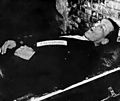Nuremberg executions
The Nuremberg executions took place on the early morning of October 16, 1946, shortly after the conclusion of the Nuremberg trials. Ten prominent members of the political and military leadership of Nazi Germany were executed by hanging: Hans Frank, Wilhelm Frick, Alfred Jodl, Ernst Kaltenbrunner, Wilhelm Keitel, Joachim von Ribbentrop, Alfred Rosenberg, Fritz Sauckel, Arthur Seyss-Inquart, and Julius Streicher. Hermann Göring was also scheduled to be hanged on that day, but committed suicide using a potassium cyanide capsule the night before. Martin Bormann was also sentenced to death in absentia; at the time, his whereabouts were unknown, but it has since been confirmed that he died while attempting to escape Berlin on May 2, 1945.
For their last meal, the condemned men were served sausage and cold cuts, along with potato salad and black bread, and were given tea to drink. Starting at approximately 1:10 am, they were led one at a time to the execution chamber to be hanged. The death sentences were carried out in the gymnasium of Nuremberg Prison by the United States Army using the standard drop method (instead of the long drop method favored by British executioners). Three temporary gallows had been erected in the gymnasium, with the execution team using two in alternating order and reserving the remaining gallows as a spare.
The executioners were Master Sergeant John C. Woods and his assistant, military policeman Joseph Malta. Woods's use of standard drops for the executions meant that some of the men did not die quickly of an intended broken neck but instead strangled to death slowly. Some reports indicated some executions took from 14 to 28 minutes. The Army denied claims that the drop length was too short or that the condemned died from strangulation instead of a broken neck. Additionally, the trapdoor was too small, such that several of the condemned suffered bleeding head injuries when they hit the sides of the trapdoor while dropping through. The bodies were rumored to have been taken to Dachau for cremation but were incinerated in a crematorium in Munich and the ashes scattered over the river Isar.
Kingsbury Smith of the International News Service wrote an eyewitness account of the hangings. His account, accompanied by photos, appeared in newspapers.
Order of executions
- The body of Hermann Göring who had committed suicide pre-empting execution
- The body of Joachim von Ribbentrop
- The body of Wilhelm Keitel
- The body of Ernst Kaltenbrunner
- The body of Alfred Rosenberg
- The body of Hans Frank
- The body of Wilhelm Frick
- The body of Julius Streicher
- The body of Fritz Sauckel
- The body of Alfred Jodl
- The body of Arthur Seyss-Inquart










